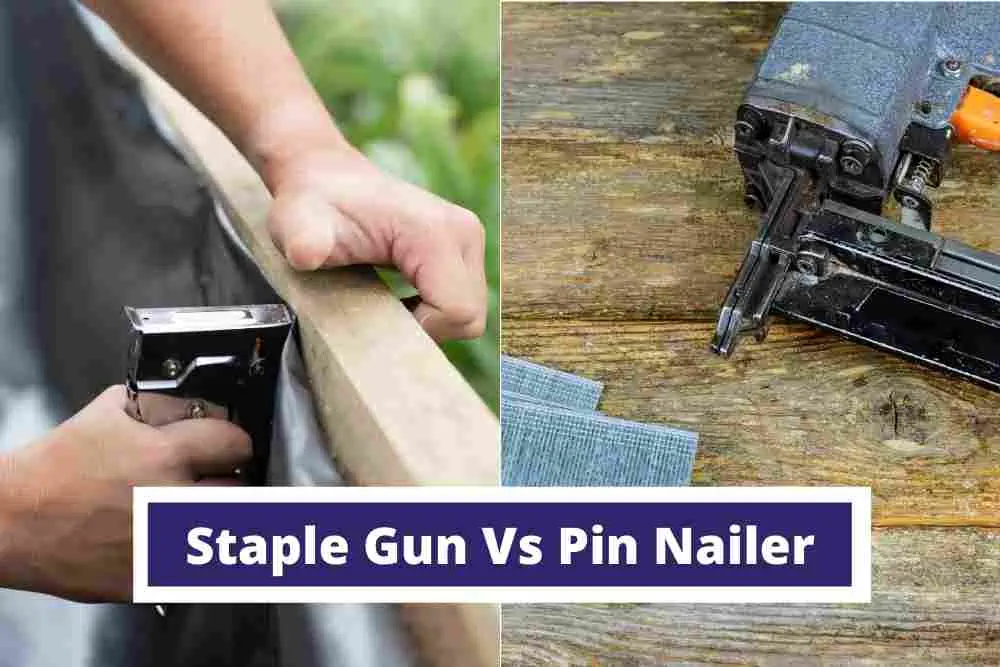When it comes time to choose a tool for a project, there are many options to choose from. Two of the most popular tools are the staple gun and the pin nailer. Both have their own benefits and drawbacks, which can make it difficult to decide which one is right for the job.
In this article, we will compare and contrast the two tools, and help you decide which one is best for your needs.

Pin Nailer vs Staple Gun: Which one is Better to Use
The staple gun and the pin nailer are two very different tools, but they both have their place in the workshop.
The pin nailer is a smaller, more lightweight option that’s good for precision nailing.
The pin nailer is a simple tool that consists of a handle, a magazine that holds the pins, and a firing mechanism. When you pull the trigger, the pins are fired out of the magazine and into whatever you’re attaching them to.
The staple gun is a great choice for attaching things together quickly and easily. You can use it to attach fabric to wood, attach trim around windows and doors, or even attach metal cabinet hardware.
Let’s break down the following chart of staple guns VS Pin nail guns so you can easily compare them.
| Staple Gun | Pin Nail Gun |
| Suitable for heavy-duty projects | Suitable for lightweight projects |
| It is hard enough to carry because of large size and weighty designs | The lightweight and compact designs help the users easily portable it |
| Comes with large head size | Comes with small head size |
| Powerful and quickly complete the tasks | It comes with less power than staple gun |
Pros. of Using Pin Nailer
A pin nailer is a tool that uses pins to fasten pieces of wood together. They are often used in furniture making and other carpentry projects.
-Pin nailers are easy to use and don’t require much power. This makes them ideal for smaller projects or delicate work.
-The pins are small and precision-pointed, so they won’t cause any damage to the surface you’re working on.
-Pin nailers are also very quiet, so they won’t disturb your neighbors or co-workers.
-They’re also lightweight and easy to carry around, making them perfect for on-the-go use.
-Pin nails are very small and almost invisible when they are driven into the wood. This makes them a good choice for projects where you want a clean, finished look.
-Pin nails have a low profile, which means they don’t create as much of a noticeable indentation as larger nails do.
-Pin nails are less likely to split the wood than other types of nails. This makes them ideal for delicate work or for use on thin materials.
-Pin nails can be removed easily without causing any damage to the wood.
Cons. of Using Pin Nailer
-Sometime the nail won’t penetrate the wood, too little and the nail will bend.
-Additionally, the size of nails that can be used is also limited.
Pros. of Using Staple Gun
-They are very easy to use – a staple gun is a simple tool that anyone can use without any training. You don’t require much strength or dexterity.
– They are incredibly versatile – they can be used for all sorts of projects, from upholstering furniture to securing wiring.
-They provide a strong hold – staples provide a much stronger hold than nails, meaning your project is less likely to come undone.
-They are relatively cheap – compared to other types of fasteners, staple guns are relatively affordable.
-Their small size means they can be used in tight spaces – unlike screws or nails, staples can be fired into small spaces without causing any damage.
-They are easy to remove – if you need to remove a staple, it’s easy to do so without causing any damage.
Cons. of Using Staple Gun
There are many reasons why a staple gun should not be used as the only means of fastening materials together.
-The main disadvantage is the limitation of what the staple gun can do. It is not as versatile as other methods such as screws, nails, or adhesives.
-A staple gun cannot be used on materials that are too thick or too thin.
-It also cannot be used on curved surfaces.
FAQs (Frequently Ask Questions)
Q: Do staples hold better than nails?
Answer: I think not. Staple nail guns are lightweight and provide less power than nail guns. On the other hand, different nail guns hold different nails you can consider your own. Some of the staplers also hold more nails than a nail gun.
Q: Is a pin nailer the same as a finish nailer?
Answer: The pin nail guns are commonly pronounced as finish nail guns. Though the name and some features look similar, they have some differences. However, a finish nail gun is wider than a pin nail gun.
Final Words
In conclusion, a staple gun is more versatile and easier to use than a pin nailer. It is also less expensive. A pin nailer is better for small, precise jobs.